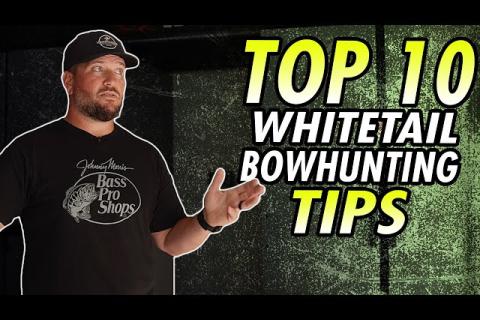
10 Essential Whitetail Bowhunting Tips for a More Successful Season
Featuring Michael Hunsucker, Heartland Bowhunter
? 10 Whitetail Bowhunting Tips You Can't Miss!
Getting ready for whitetail bow season takes more than just checking gear and hoping for the best. Whether you are a first-time bowhunter or someone who has spent decades in the tree stand, success often comes down to how well you prepare, how smart you hunt, and how calm you stay when it counts.
Michael Hunsucker’s Bowhunting Strategies
Michael Hunsucker from Heartland Bowhunter shares ten of his most important bowhunting strategies that have helped him consistently tag mature bucks. From early-season preparation to post-shot recovery, these tips are rooted in real-world experience and designed to help you make the most of every opportunity in the field.
1. Prepare Early for the Whitetail Archery Season
Start getting ready weeks before opening day. Hang and inspect stands, clear shooting lanes, check all safety equipment, and begin practicing with your bow in real hunting conditions. Dial in your sights, shoot broadheads, and fine-tune every part of your setup.
2. Scout Smart and Avoid Pressure
Scouting is critical, but it must be done without alerting deer to your presence. Use cellular trail cameras to monitor movement remotely, glass summer feeding areas like soybean fields, and resist the temptation to walk through bedding areas. The less human scent you leave behind, the better your odds.
3. Identify What Deer Need Most on Your Property
Deer require food, water, and cover. Look at your hunting area and determine which resource is limited. If there is only one water source or one thick bedding area, deer will concentrate near it. Focus your setups around these high-value locations.
4. Hunt the Perimeter First
Do not rush into your best spots right away. Begin by hunting the edges of a property where you can observe without causing disturbance. Once you identify a target buck or solid pattern, gradually move closer. This helps extend the life of your hunting areas throughout the season.
5. Watch for Ideal Weather Conditions
Cold fronts and high-pressure systems can dramatically increase daytime deer movement. Even a small drop in temperature can get deer on their feet. Hunt days with consistent wind direction and avoid swirling or variable winds that can give away your position.
6. Plan Your Entry and Exit Routes Carefully
Access is one of the most overlooked factors in bowhunting. If deer see or smell you entering or leaving your stand, the spot may be ruined for days. Use terrain features, creeks, or standing crops to hide your approach and minimize scent. Your entrance and exit routes may need to differ depending on wind direction.
7. Observe Deer Behavior and Body Language
Pay attention to how deer act in real-time. Watch how does and young bucks respond to movement, scent, and sound. If a mature buck is nearby, their body language can give you clues about when and where to draw your bow.
8. Mentally Prepare for the Shot Opportunity
Even experienced hunters can struggle when adrenaline spikes. Confidence in your gear and shooting ability comes from repetition and mental focus. Visualize the shot, breathe steadily, and stay composed. The ability to stay calm in the moment is what separates successful bowhunters from those who freeze up.
9. Aim Small and Follow Through
When a buck steps into range, do not just aim broadly at the vitals. Pick a specific spot and execute the shot you have practiced. Follow through, watch where your arrow hits, and stay engaged after the shot. Many hunters forget these critical steps in the heat of the moment.
10. Do Not Rush the Recovery
If you are not sure about your shot or do not see the deer fall, back out and wait. Evaluate the hit based on arrow location, blood sign, and behavior. Liver and gut shots often require several hours. Patience can mean the difference between recovering your deer and losing it.
Michael Hunsucker’s 10 Bowhunting Tips Checklist
- Prepare early: hang stands, clear lanes, check gear, and practice with your bow.
- Scout smart: use trail cams, glass fields, and avoid disturbing bedding areas.
- Identify the limited resource: focus on food, water, or cover based on your property.
- Hunt from the outside in: start conservatively and move closer based on observations.
- Wait for the right conditions: hunt cold fronts, high pressure, and steady winds.
- Plan your access: use terrain and wind to enter and exit stands undetected.
- Observe deer behavior: read body language to anticipate movement and shot opportunity.
- Mentally prepare: build confidence, visualize success, and stay calm in the moment.
- Pick a spot: aim small, follow through, and track your shot carefully.
- Do not rush recovery: if unsure, back out and give the deer time before tracking.
? Shop Online
Shop Bowhunting Gear at Bass Pro
Explore Archery Gear at Cabela's
? Visit a Store Near You
- 581 views

